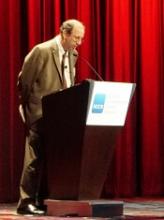Novel agents changing treatment algorithm in AML
NEW YORK—Recent drug approvals for acute myeloid leukemia (AML) have greatly expanded options for treating patients, according to a presentation at the NCCN 13th Annual Congress: Hematologic Malignancies.
Richard M. Stone, MD, of the Dana-Farber Cancer Institute in Boston, M.A., gave this presentation, providing some guidance for how to incorporate newly approved AML drugs into practice.
Dr. Stone also discussed therapies and treatment strategies that are under investigation.
Midostaurin
Midostaurin was approved by the U.S. Food and Drug Administration (FDA) in 2017. It is approved for use in combination with standard cytarabine and daunorubicin induction, followed by cytarabine consolidation, in adults with newly diagnosed AML who are FLT3-mutation-positive, as detected by an FDA-approved test.
Even though FLT3-ITD mutation confers a bad prognosis in AML, midostaurin capitalizes on the activated enzyme by inhibiting it.
The RATIFY trial (CALGB 10603) enrolled only FLT3-mutated AML patients younger than 60 and randomized them to induction and consolidation with or without midostaurin.
“Bottom line, being on midostaurin was a good thing,” Dr. Stone said.
Midostaurin led to a 23% reduction in the risk of death, and the 4-year survival rate was improved by about 7%.
“What is meaningful, if you happen to get a transplant in CR1 [first complete remission], you may be going to transplant with lower disease burden,” Dr. Stone explained. “Adding midostaurin is probably a good thing for mutated FLT3.”
The addition of midostaurin to induction may also be appropriate for fit older adults with FLT3 mutations, Dr. Stone said.
Gemtuzumab ozogamicin
The antibody-drug conjugate gemtuzumab ozogamicin has been around for almost 20 years and has an “interesting” history, according to Dr. Stone.
Gemtuzumab ozogamicin was first approved by the FDA in 2000, based on a 30% remission rate in relapsed AML.
However, the agent was voluntarily withdrawn from the market in 2010 because it was used in the upfront setting with chemotherapy and didn’t show a benefit.
Recent studies of the agent suggested use of the agent should be revisited but with lower doses.
Data from the ALFA 0701 study was key for the FDA’s re-approval of gemtuzumab in 2017.
According to Dr. Stone, the most important finding of this trial was the major event-free survival benefit for those on gemtuzumab, which was 41% at 2 years, compared to 17% for the control group.
Overall survival, however, was not significantly superior with gemtuzumab.
A meta-analysis of 5 trials showed that adding gemtuzumab to treatment of patients with favorable and intermediate risk conferred a survival advantage, but this was not the case in patients with adverse-risk cytogenetics.
Fit older adults with CBF mutation may benefit from the addition of gemtuzumab, Dr. Stone said.
He also pointed out that gemtuzumab has a big “booby prize,” which is veno-occlusive disease, shown to be a problem with high doses of gemtuzumab and transplant.
CPX-351
CPX-351 is a liposomal co-formulation of cytarabine and daunorubicin, the two drugs delivered separately in the standard induction chemotherapy referred to as 7+3.
Last year, the FDA approved CPX-351 to treat adults who have AML with myelodysplasia-related changes or newly diagnosed, therapy-related AML.
In a phase 3 trial, CPX-351 conferred a survival advantage over standard 7+3. There was a 31% reduction in the risk of death with CPX-351.
Patients who went on to transplant after CPX-351 did much better than patients who received 7+3 and transplant, with a hazard ratio of 0.51.
Dr. Stone noted that minimal residual disease was not measured, “but it’s quite possible that patients who had CPX went into transplant with a lower level of disease burden.”







